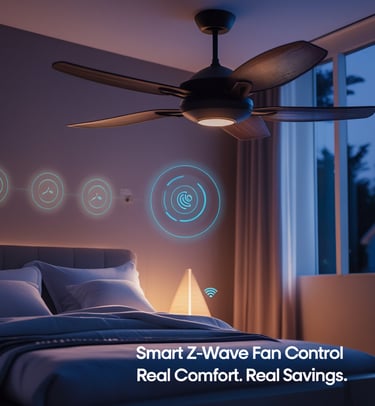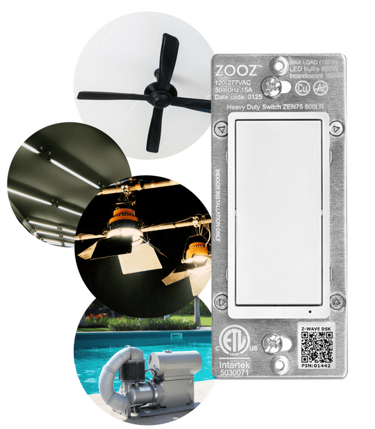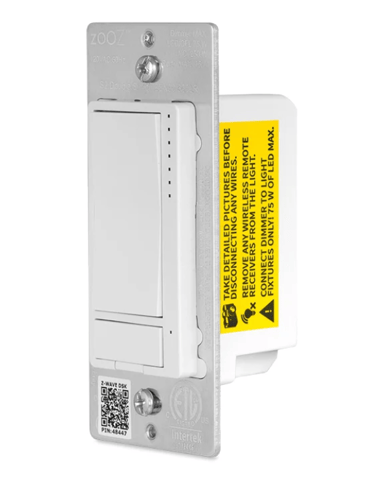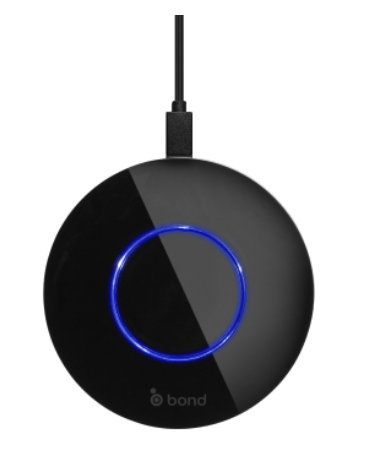Smart Fan Control: 3 Z-Wave Solutions for Energy-Efficient Ceiling Fans
Discover Three smart Z-Wave solutions for energy-efficient ceiling fan control. Make your home more smarter and more responsive with these top Z-Wave solutions.
SMART HOME TECHNOLOGY
Sophia Reed
7/8/20257 min read


Smart Z-Wave Fan Control: A Homeowner's Real Experience with Energy-Efficient Automation
Let me paint you a picture. It's 11 PM on a sweltering July night, and I'm finally crawling into bed after a long day. That's when I notice it-the ceiling fan isn't running. Now I have to get up, fumble for the wall switch in the dark, and hope I don't stub my toe on the dresser. Sound familiar?
Or how about this one: I'm rushing out the door for an important meeting, and halfway down the street, I get that sinking feeling. Did I turn off the bathroom exhaust fan? It's been running since my morning shower, and now it's going to run all day, wasting energy and money.
These little moments of frustration were exactly what pushed me into the world of smart home technology. And let me tell you, after three years of experimenting with different systems, I've learned that smart fan control is about so much more than just convenience-though I'll admit, controlling fans with my voice or phone never gets old.
Why I Chose Z-Wave Over Everything Else
When I first started researching smart home options, I was completely overwhelmed. WiFi switches, Bluetooth controls, proprietary apps-it felt like I needed a computer science degree just to turn on a fan. Then a friend who works in home automation introduced me to Z-Wave, and honestly, it changed everything.
The Network That Actually Works
Here's what sold me on Z-Wave: every device creates a mesh network. Think of it like having multiple pathways to reach your destination. If one road is blocked, your GPS finds another route. That's exactly how Z-Wave works in your home.
This was huge for my setup because I have a large, older home with thick walls. My WiFi signal barely reaches the master bedroom, let alone the ceiling fan up there. But with Z-Wave, each device extends the network, so even my farthest fan gets reliable signals.
No More Interference Headaches
I learned this lesson the hard way with my first smart home attempt. I installed WiFi-based switches throughout the house, and they worked great-until everyone came home and started streaming videos, video calling, and gaming. Suddenly, my fan controls became unreliable.
Z-Wave operates on its own frequency (908.42 MHz here in the US), completely separate from WiFi and Bluetooth. My fans respond consistently whether I have one device connected or twenty devices fighting for WiFi bandwidth
Energy Savings That Show Up on My Bill
This is where Z-Wave really impressed me. Instead of just having "on" and "off" options, I can create detailed schedules and rules. My bathroom fan turns on automatically when humidity spikes and shuts off when levels return to normal. My bedroom fan adjusts speed based on temperature throughout the day.
The result? My electric bill dropped by about $25 per month during peak summer months. That might not sound like much, but it's paid for my entire smart fan system in less than two years.
The Three Solutions That Actually Work
I've tried a lot of different products over the years, and most ended up in my "lessons learned" pile. These three, however, have proven themselves in daily use through Texas summers and unpredictable spring weather.
My first attempt at smart fan control was a disaster. I bought a regular smart switch thinking it would work fine. Three weeks later, it died. Turns out, ceiling fans have different electrical requirements than regular lights, and most switches aren't designed to handle motor loads.
The Zooz ZEN75 was specifically engineered for fans, and the difference is night and day. I've had mine installed for over two years now, controlling a large master bedroom fan that runs almost constantly during summer months. Zero issues.
What I love about it:
It handles my big, heavy-duty fans without overheating
Installation was straightforward (though I did hire an electrician for the first one)
Even when my hub is offline, I can still control the fan manually
Installation tip:
Check your fan's specifications before buying any smart switch. I made the mistake of assuming all fans were the same-they're definitely not. Also, take photos of your existing wiring before disconnecting anything. Trust me on this one.
My guest bathroom had one of those combination fan-light fixtures with a single switch controlling both. It was all or nothing-if I wanted the light, I got the fan too. The ZEN30 solved this perfectly by giving me independent control of both in the same wall space.
Why it's brilliant:
The main paddle controls the light, while a separate button controls the fan
Fits in a standard single-gang box (important in my 1970s home)
I can automate them separately-light comes on with motion, fan comes on with humidity
Make sure your existing wiring supports dual control. Most modern homes are fine, but older houses might need some additional electrical work. I was lucky-my electrician confirmed my wiring was compatible during installation.
Word of warning:
This one solved a problem I thought was impossible. My living room has a beautiful ceiling fan that came with the house, but it only had an RF remote control. I assumed I was stuck with that basic remote forever.
The Bond Bridge completely changed that. It learns your existing remote's signals and then mimics them, giving you smart control without replacing anything.
How it transformed my setup:
No electrical work required-it communicates wirelessly.
Works with most RF remote fans (mine was compatible)
Integrates perfectly with my Z-Wave hub
Setup advice:
Take your time during the learning process. I rushed through it the first time and had to start over. Test each function thoroughly before setting up any automated routines.
Building a System That Actually Helps
Once you have basic smart fan control working, you can start adding sensors and automation that make a real difference in daily life. This is where the technology stops being a novelty and starts being genuinely useful.
The Hub: Your System's Brain
I've used several different Z-Wave hubs, and the Zooz Z-Box Hub has become my go-to recommendation. It's designed specifically for Z-Wave devices rather than trying to do everything, and the performance difference is noticeable.
Why I stick with it:
Handles complex automation without slowing down
The interface actually makes sense (not always a given with smart home tech)
Works reliably with all the sensors I've added
Humidity Sensors: The Bathroom Revolution
Adding humidity sensors to bathroom fans was one of those "why didn't I do this years ago" moments. The Zooz ZSE44 Temperature and Humidity Sensor automatically triggers the fan when moisture levels rise and shuts it off when the air clears.
Real-world impact:
No more forgetting to turn on the fan during showers
No more leaving it running for hours after I'm done
My bathroom stays fresher, and I'm not wasting electricity
Energy usage for bathroom fans dropped by about 40%
Motion and Temperature Sensors: Comfort Automation
Motion sensors ensure fans only run when people are actually in the room, while temperature sensors adjust fan speed based on how warm it gets. The Zooz ZSE18 Motion Sensor and ZSE11 Q Sensor work great for this.
My daily experience:
In bedrooms, temperature-based automation gradually increases fan speed as rooms warm up during the day. In common areas, motion sensors turn fans off when everyone leaves. It's subtle, but the comfort improvement is noticeable, and the energy savings add up.
Advanced Techniques I've Discovered
After three years of experimenting, I've found some techniques that go beyond basic automation.
Ceiling-Level Control with the ZEN52
The Zooz ZEN52 Double Relay installs directly at the ceiling fixture, allowing you to separate fan and light control without rewiring wall switches. This saved me in my rental property, where I couldn't modify wall switches but still wanted smart control.
When I recommend it:
Rental properties with restrictions on electrical modifications
Older homes where running new wiring would be expensive
Situations where you want to keep existing wall switch appearance
Getting the most out of the Bond Bridge requires understanding how it integrates with your Z-Wave system. I learned to set up automations within my Z-Wave hub rather than relying solely on the Bond app.
The Real-World Results
After three years of using Z-Wave fan control, I can honestly say it's one of the most practical smart home investments I've made. The combination of energy savings, convenience, and improved comfort makes it worthwhile, even for people who aren't tech enthusiasts.
The three solutions I've outlined-the Zooz ZEN75 for direct control, the ZEN30 for combination setups, and the Bond Bridge for RF fans-cover most situations you'll encounter. Add some sensors for advanced automation, and you'll have a system that genuinely improves daily life while saving money.
My advice? Start simple and build up. Install one solution, get comfortable with it, then gradually add sensors and more sophisticated automation as you discover what works best for your specific situation.
Common Questions from Friends and Family
1. Is Z-Wave really that much better than WiFi switches?
In my experience, yes. The mesh network and dedicated frequency make it much more reliable. I've had friends struggle with WiFi switches that work great for a few months, then become unreliable as their network gets busier.
2. How much money can I actually save?
This depends on your usage patterns and local energy rates, but I've seen 20-30% reduction in fan-related energy consumption through smart automation. For me, that's about $25-30 per month during peak summer months.
3. What happens if my hub fails?
Most Z-Wave fan switches can still be operated manually even if the hub is down. Your automation stops working, but basic fan function remains. I've never had a complete system failure, but it's reassuring to know I'm not locked out of basic controls.





